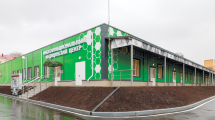Conclusion
-
1.
It was observed in 1953 and in 1955, that convalescent sera of measles taken from patients several times following the disease-days showed the formation of antibodies for neutralization and complement fixation.
-
2.
Sera of patients, inmates or parents who showed no symptoms of measles, showed a gradual increase in titers of neutralization and complement fixation antibodies against the mouse-adapted measles virus.
-
3.
Sera of 107 measles patients taken in 1956 to 1957, successively 3 to 5 times at various intervals during the course of illness were subjected to complement fixation test using antigen prepared from the mouse adapted measles virus.
Out of 107 patients, 75 developed specific antibodies against measles. The appearance of the antibodies was observed mostly within 3 months after contraction and its disappearance within the period from 4 to 6 months. No difference was noted between the two sexes in regard to the rate of complement fixation, but when classified by age it was comparatively lower in the age group under 3 years as compared with that over 3 years. Similar antibody response was usually observed among members of the same family.
Similar content being viewed by others
References
Arakawa, S.: Japan J. Exp. Med.20, 351 (1949).
Arakawa, S.: Z. Hyg.139, 227 (1954).
Arakawa, S., J. Hoshino, H. Nagashima, T. Kaneko andT. Seki: Arch. Virusforsch.9, 647 (1959).
Wada, M. andY. Ogawa: Virus5, 13 (1953);Wada M., J. Kyoto Prefect. Med. Univ.62, 483 (1957) (in Japanese).
Fujita, M.: Virus5, 13 (1953) (in Japanese).
Yamada, S.: Grakujutsu Geppo Bessatsu Shiryo22, 98 (1951) (in Japanese).
Rokutanda, T.: ibid22, 253 (1951) (in Japanese).
Takabayashi, S.: Kumamoto Iggakkai Zasshi27, 377 (1953) (in Japanese).
Degkwitz, R.: Z. Kinderhk.25, 134 (1920) Z. Kinderhk.27, 171 (1921).
Erdheim, S.: Brit. J. Child. Dis.23, 195 (1926).
Enders, J. F. andT. C. Peebles: Proc. Soc. Exp. Biol. & Med.86, 277 (1954).
Ruckle, G. andK. D. Rogers: J. Immunol.78, 341 (1957).
Anthony, K. G., J. Warren, C. Goldman, andB. Jeffries: Proc. Soc. Exp. Biol. & Med.98, 18 (1958).
Fulton, F. andF. R. Dumbell: J. Gen. Microbiol.3, 97 (1949).
Author information
Authors and Affiliations
Additional information
The essentials of this paper were read at the general meeting of the Japanese Association for Infectious Diseases held in Nagoya on April 2nd, 1954 and in Kyoto on April 4th, 1955 and at the general meeting of the Japan Bacteriological Society held on April 8th, 1958 and at the general meeting of the Societas paediatrica japonica in Kobe on April 23rd, 1958, respectively. This study was in part aided by grant from the Ministry of Education in 1956, and Japan Waksman Foundation in 1958.
The authors wish to acknowledge Professor HidetakeYaoi, Professor TomoichiroAkiba and Dr. ShuichiYamada for their kind advices.
Rights and permissions
About this article
Cite this article
Arakawa, S., Hoshino, J., Kaneko, T. et al. Experimental study on measles virus. Archiv f Virusforschung 9, 656–664 (1960). https://doi.org/10.1007/BF01242151
Received:
Issue Date:
DOI: https://doi.org/10.1007/BF01242151




